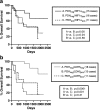Pyruvate dehydrogenase and pyruvate dehydrogenase kinase expression in non small cell lung cancer and tumor-associated stroma
- PMID: 15736311
- PMCID: PMC1490315
- DOI: 10.1593/neo.04373
Pyruvate dehydrogenase and pyruvate dehydrogenase kinase expression in non small cell lung cancer and tumor-associated stroma
Abstract
Pyruvate dehydrogenase (PDH) catalyzes the conversion of pyruvate to acetyl-coenzyme A, which enters into the Krebs cycle, providing adenosine triphosphate (ATP) to the cell. PDH activity is under the control of pyruvate dehydrogenase kinases (PDKs). Under hypoxic conditions, conversion of pyruvate to lactate occurs, a reaction catalyzed by lactate dehydrogenase 5 (LDH5). In cancer cells, however pyruvate is transformed to lactate occurs, regardless of the presence of oxygen (aerobic glycolysis/Warburg effect). Although, hypoxic intratumoral conditions account for HIF1alpha stabilization and induction of anaerobic metabolism, recent data suggest that high pyruvate concentrations also result in HIF1alpha stabilization independently of hypoxia. In the present immunohistochemical study, we provide evidence that the PDH/PDK pathway is repressed in 73% of non small cell lung carcinomas, which may be a key reason for HIF1alpha stabilization and "aerobic glycolysis." However, about half of PDH-HIF pathway, and patients harboring these tumors have an excellent postoperative outcome. A small subgroup of clinically aggressive tumors maintains a coherent PDH and HIF/LDH5 expression. In contrast to cancer cells, fibroblasts in the tumor supporting stroma exhibit an intense PDH but reduced PDK1 expression favoring maximum PDH activity. This means that stroma may use lactic acid produced by tumor cells, preventing the creation of an intolerable intratumoral acidic environment at the same time.
Figures


References
-
- Harris RA, Bowker-Kinley MM, Hyang B, Wu P. Regulation of the activity of the pyruvate dehydrogenase complex. Adv Enzyme Regul. 2002;42:2249–2259. - PubMed
-
- Reed LJ, Hackert ML. Structure-function relationships in dihydrolipoamide acyltransferases. J Biol Chem. 1990;265:8971–8974. - PubMed
-
- Sanderson SJ, Miller C, Lindsay JG. Stoichiometry, organisation and catalytic function of protein X of the pyruvate dehydrogenase complex from bovine heart. Eur J Biochem. 1996;236:68–77. - PubMed
-
- Maeng CY, Yazdi MA, Niu XD, Lee HY, Reed LJ. Expression, purification, and characterization of the dihydrolipoamide dehydrogenase-binding protein of the pyruvate dehydrogenase complex from Saccharomyces cerevisiae. Biochemistry. 1994;33:13801–13807. - PubMed
-
- Harris RA, Bowker-Kinley MM, Wu P, Jeng J, Popov KM. Dihydrolipoamide dehydrogenase-binding protein of the human pyruvate dehydrogenase complex. DNA-derived amino acid sequence, expression, and reconstitution of the pyruvate dehydrogenase complex. J Biol Chem. 1997;272:19746–19751. - PubMed
Publication types
MeSH terms
Substances
LinkOut - more resources
Full Text Sources
Other Literature Sources
Medical
Miscellaneous
